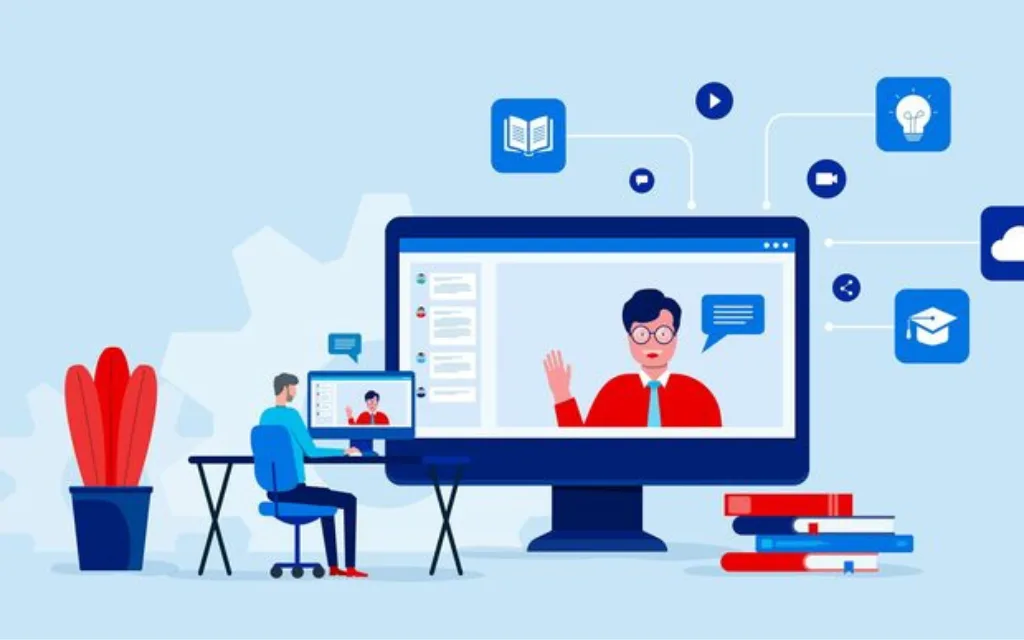How Online Education is in essential powerful way Transforming Learning in Today’s Digital Age2025
Introduction: The Rise of Online Education
In recent years, online education has emerged as a transformative force in the world of learning. With rapid advances in digital technology and the increasing availability of the internet across the globe, education is no longer confined to the four walls of a classroom. From secondary schools to universities and professional development programs, more learners are embracing online platforms to gain knowledge, develop skills, and earn qualifications.
One of the key drivers behind this shift is the flexibility and accessibility that online education offers. Students can learn from anywhere, at any time, often at their own pace. This is especially valuable for those balancing education with work, family, or other commitments. Whether it’s a teenager completing high school courses remotely, an adult pursuing a degree while working full-time, or a professional taking short courses to upgrade their skills, online learning provides a customizable path to education that suits diverse needs and lifestyles.
Moreover, the global COVID-19 pandemic accelerated the adoption of online learning, pushing many institutions to reimagine how education is delivered. Even as traditional in-person classes have resumed in many places, the convenience and effectiveness of digital learning have secured its place as a permanent fixture in modern education systems.
However, while online education presents many benefits, it also comes with its own set of challenges—including issues of digital access, student engagement, and quality assurance. It requires a different approach to teaching, learning, and assessment, and depends heavily on both technological infrastructure and student self-motivation.
This article explores the various dimensions of online education:
- What it is and how it functions,
- The benefits and opportunities it provides,
- The barriers and limitations learners and institutions must overcome,
- The technological tools and resources needed to make it effective,
- And what the future might look like as education continues to evolve in the digital age.
Whether you are an educator, a student, a parent, or simply someone curious about the future of learning, understanding the rise of online education is key to navigating and contributing to the next generation of global education.

What Is Online Education
Online education refers to learning experiences delivered through digital platforms rather than in person. It includes courses delivered over the internet, virtual classrooms, webinars, and remote learning. Students connect via computers or mobile devices. Instructors provide lectures, assignments, quizzes through learning management systems. The goal is to make education accessible without requiring a physical classroom.
Relevant phrases include e learning, distance education, virtual learning environment, remote instruction, and digital learning. Online education often uses multimedia materials such as video lectures, interactive modules, and recorded seminars. It also depends heavily on technology such as video conferencing tools and collaborative applications to mimic classroom interaction. In many ways online education blends formal and informal learning by allowing learners to participate from home, work, or anywhere with internet.
Key Features of Online Education
Flexibility and Convenience
One of the most significant and widely recognized advantages of online education is the flexibility it provides. Unlike traditional classroom-based learning, which often requires strict adherence to schedules, physical attendance, and fixed locations, online education allows learners to tailor their educational experiences to fit their individual needs and lifestyles.
In a conventional setting, students are typically required to travel to campus, attend classes at specific times, and follow a predetermined academic calendar. This structure can be restrictive, particularly for individuals who are balancing education with other responsibilities such as work, childcare, or personal obligations. Online education removes many of these barriers by giving students greater control over when, where, and how they learn.
With digital learning platforms, students can access course materials, watch lectures, participate in discussions, and complete assignments at any time of the day or night. This level of time flexibility is particularly beneficial for adult learners, working professionals, caregivers, and those living in different time zones. For example, a full-time employee can study in the evenings, and a parent can schedule lessons around their child’s routine—all without sacrificing educational goals.
Geographical flexibility is another major benefit. There is no need to commute long distances or relocate to attend a particular institution. This not only saves time and money but also eliminates stress associated with travel, traffic, or finding housing near campus. Students can enroll in top-tier programs from prestigious institutions around the world without ever leaving their homes.
Online courses are generally offered in two main formats:
- Asynchronous learning, where students access pre-recorded lectures, reading materials, and assignments on their own schedule. This model is ideal for those who need maximum flexibility and prefer to learn at their own pace.
- Synchronous learning, where students attend live, scheduled sessions via video conferencing. This format offers real-time interaction with instructors and classmates, combining the structure of traditional classrooms with the convenience of remote access.
Beyond convenience, this flexibility also supports personalized learning. Students can pause, rewind, or rewatch instructional videos, allowing them to spend more time on challenging topics or move quickly through content they already understand. This autonomy fosters self-discipline and responsibility, encouraging learners to take ownership of their educational journey.
Over time, this self-directed approach helps develop valuable skills such as time management, problem-solving, and independent learning—all of which are highly valued in both academic and professional settings.
In essence, online education redefines the learning experience by putting the student at the center. It empowers individuals to pursue knowledge and advancement on their own terms, making education more accessible, inclusive, and adaptable than ever before.

Accessibility and Reach
Online education has transformed how and where learning takes place. One of its most revolutionary aspects is how it removes physical and geographical barriers. Students from rural areas, remote villages, or countries with limited educational infrastructure now have the ability to learn from institutions and instructors located anywhere in the world.
Through online education, someone in a small town can take a course from a leading university across the globe without ever leaving home. This democratization of education helps to reduce inequality and expand access to quality learning for people from all walks of life. It also allows students to interact with diverse cultures, perspectives, and ideas, enriching their academic experience.
Inclusion is further supported when digital courses are designed to accommodate a variety of learning needs. Features such as subtitles or closed captions make learning more accessible for students with hearing impairments. Translated content and multilingual resources can help non-native speakers understand complex materials. Many platforms also offer screen reader support and other tools that cater to students with different abilities.
Moreover, online education often comes with affordable or even free options. Learners can choose from a wide range of courses without worrying about the high cost of tuition, travel, or accommodation. Scholarships, installment payment plans, and government-sponsored programs further lower the financial barrier. This affordability makes online education a powerful tool for social inclusion and upward mobility.
Variety of Learning Materials
Another key strength of online education lies in the vast and varied types of learning materials it offers. Unlike traditional classrooms that rely heavily on textbooks and lectures, online education platforms deliver content in multiple engaging formats. These include streaming video lessons, interactive quizzes, downloadable PDFs, virtual simulations, podcasts, live discussions, and more.
This diversity caters to different learning styles. Visual learners may benefit from videos and infographics. Auditory learners can absorb information through lectures or audio recordings. Kinesthetic learners can take part in simulations, games, or virtual labs that allow hands-on practice in a digital space. This personalized approach to content delivery increases engagement and improves understanding.
One of the most important tools in online education is the Learning Management System (LMS). An LMS is the central hub where students can access course content, submit assignments, track their progress, and communicate with instructors or peers. Examples include platforms like Moodle, Blackboard, Google Classroom, and Canvas. These systems make it easy to organize content in structured ways, so students always know what’s next and where they stand academically.
Instructors can also enrich the digital learning environment by regularly updating materials to reflect current trends, new research, or feedback from students. In online education, content is not static—it evolves to meet the needs of learners. In some courses, artificial intelligence is used to recommend extra materials based on a student’s performance, helping them reinforce weaker areas.
Moreover, discussion forums and chat rooms add another dimension to online education. They allow learners to connect with peers, ask questions, share opinions, and build a sense of community, even if they are thousands of miles apart. This interactivity ensures that learning is not a one-way process but a collaborative experience.
Simulations and gamified content are also becoming more common in online education. For example, medical students can practice diagnosing conditions through virtual patients. Business students can run simulations of company strategies. These tools make learning not only more engaging but also more practical and real-world relevant.
Online education continues to develop and diversify, and these key features are central to its growth. Flexibility, accessibility, and the variety of engaging materials all work together to provide a rich, learner-centered experience. As technology advances, these features will likely become even more powerful, giving learners greater control and deeper understanding of their subjects.
Tools and Technologies Behind Online Education

Learning Management Systems and Platforms
Platforms such as Moodle, Canvas, and proprietary systems from universities support online education by managing lessons, assignments, grading, and communication. They host course materials and track student progress. These platforms may also include virtual classrooms for live lectures.
Support and Community Building
A strong support system is essential for ensuring student success in online education. Unlike traditional classroom settings, online learning can often feel isolating, which can lead to disengagement or dropout. Building a sense of community and offering robust support can significantly improve learner satisfaction, motivation, and academic outcomes.
Mentorship programs, where experienced students or professionals guide new learners, can offer personalized advice, encouragement, and practical tips for navigating online learning. These relationships foster a sense of connection and belonging.
Online forums, peer discussion boards, and study groups provide platforms for learners to collaborate, ask questions, and share knowledge. These peer-to-peer interactions replicate classroom dynamics and promote deeper understanding through dialogue.
Instructor engagement is also critical. Regular and timely feedback on assignments, as well as responses to student inquiries, help learners stay on track and feel supported. Instructors who maintain an active presence through announcements, discussion participation, or feedback loops encourage continuous engagement.
Additionally, virtual meetups, webinars, and live office hours create opportunities for real-time interaction. These sessions allow students to raise concerns, seek clarification, and build rapport with instructors and peers.
The formation of learning communities not only reduces feelings of isolation but also increases accountability. When learners feel they are part of a group with shared goals, they are more likely to remain committed and motivated throughout the course.
Ensuring Technical Access
Delivering high-quality online education also requires that all learners have equitable access to the necessary technology. Without reliable internet, appropriate devices, and access to educational tools, students may struggle to participate fully in online learning environments.
Reliable internet connectivity is a fundamental requirement. However, many students, especially those in rural or underserved areas, face challenges such as unstable connections or limited bandwidth. Institutions can address this by designing course materials that are optimized for low-bandwidth environments, including text-based content, downloadable resources, and compressed video files.
Students also need access to suitable devices, such as laptops or tablets, which can handle the technical demands of online platforms and course software. Educational institutions can play a proactive role by offering device loan programs, financial aid, or grants to ensure all students are equipped to participate.
Moreover, access to necessary software and digital tools must be considered. Providing students with free or discounted licenses for essential tools—such as productivity suites, design software, or virtual labs—can enhance learning outcomes and reduce financial strain.
For students with inconsistent connectivity, institutions should consider offering offline-compatible resources, such as printable readings, pre-recorded lectures, or USB drives with course content. This approach ensures inclusivity and allows all students to learn regardless of their technological limitations.
By combining technical access initiatives with community-building efforts, educational institutions can create an inclusive, supportive, and effective online learning environment for all students.
Quality Assurance and Accreditation
Learners should check that their online education program is accredited and recognized. Accreditation ensures a degree or certificate is respected. Institutions should publish instructor credentials, course reviews, student success rates. Quality content creation matters. Regular updates ensure relevance in fields like technology or health.
Types of Online Education Models
There are different ways to deliver online education:
- Synchronous learning where learners attend live virtual classes in real time with instructors. This allows immediate interaction and schedule structure.
- Asynchronous learning where students access recorded lectures, readings, assignments on their own schedule. This offers maximum flexibility.
Hybrid models combine online and in person elements. Blended learning might have online lectures with occasional on campus labs or workshops. Massive open online courses often use asynchronous approach. Programs that prepare students for degrees may use mixed formats.
Future Trends for Online Education
Technology will continue shaping the future of online education. Artificial intelligence may personalize learning paths, adapt content to individual learners. Virtual reality and augmented reality may create immersive environments for hands on learning. Microcredentials and nano degrees may become more popular for skill building. Learning analytics will guide course improvements. Partnerships between industry and education institutions will grow so that online education aligns with workforce needs. Lifelong learning will be more common with people taking multiple short digital learning modules over their lifetime.
Real World Examples of Online Education
Some universities offer entire degree programs fully online. Organizations use online education platforms to train employees globally. Platforms like Coursera or Udemy provide courses on everything from programming to art history. In some regions online education replaced traditional schooling during emergencies or pandemics. Students used virtual classrooms, remote learning tools and digital resources to continue studies when physical attendance was impossible.
Summary of Impacts of Online Education
- It democratizes learning by making education accessible to many who were excluded before
- It fosters continuous skill development and career growth
Furthermore online education has economic effects. It reduces overhead costs for institutions, while enabling them to reach larger audiences. It also offers learners cost savings in travel, time, and materials. Socially it enables global interaction among students, exposure to diverse cultures. In education policy there is growing significance placed on digital infrastructure and equitable access. These impacts will likely expand as technology improves.
Frequently Asked Questions about Online Education
Q1 What is the difference between online education and traditional classroom learning
With online education students engage via virtual platforms rather than in person. Traditional learning requires physical presence in classrooms while online education allows learners to attend from anywhere. Interaction modes differ though both may include discussions, assignments, assessments.
Q2 Is online education effective for all types of learners
Effectiveness depends on individual learning styles. Some prefer face to face interaction, hands on practice. Others thrive in self paced digital learning. Support systems, content design, feedback help make online education work for more types of students.
Q3 How do I choose a good online education program
Look for accreditation, instructor credentials, student reviews, course structure, and available support. Consider cost and required technology. Make sure content is relevant to your goals. If possible sample some courses or modules before committing.
Q4 Can online education replace traditional universities
It may replace some functions, especially for remote learners or in continuing education. But some hands on fields, lab work, physical interaction, social experience still depend on physical presence. Hybrid models could blend best of both.
Q5 What are the costs associated with online education
Costs include tuition, platform fees, technology costs such as device and internet access. But many times online education may reduce costs related to travel, housing, printed materials. Free or low cost courses often available for skill building.







